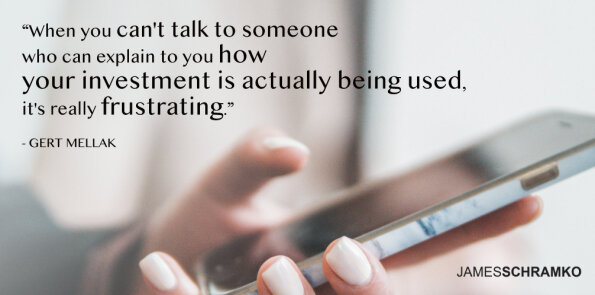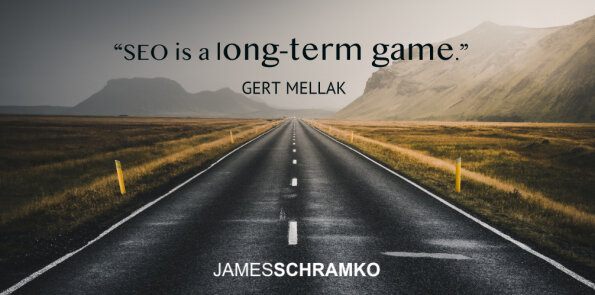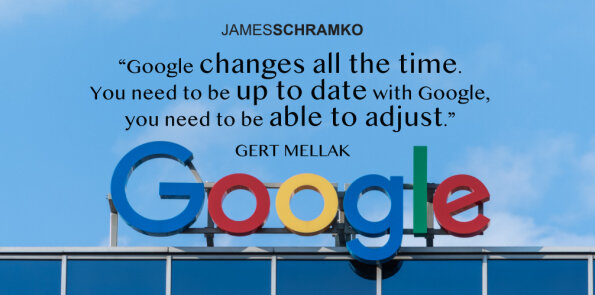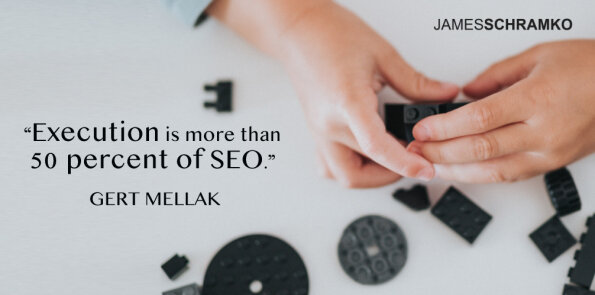Podcast: Download (Duration: 32:21 — 30.4MB)
Get Notified Of Future Episodes Apple Podcasts | Spotify | Amazon Music | Android | Blubrry | Gaana | TuneIn | Deezer | Anghami | RSS | More
Gert Mellak is a seasoned SEO professional who has led many successful campaigns for his clients. In this episode, Gert shares how his team achieved a significant conversion boost for one of their clients in just eight months.
He and James talk about Gert’s unique approach to SEO service.
They discuss the importance of working backwards from a desired result to fix what isn’t working.
And they clarify why SEO is more than just a link-building game.
Table of contents
1. Why Gert’s episodes stand out
2. The frequent case with SEO customers
3. Work with what’s there, or start from scratch?
4. What happens after the audit
5. The importance of working backwards
6. When you need to continue your effort
7. Knowing what Google wants
8. How this client reacted
9. Much more than getting links
10. At the eight months’ mark…
11. How site redesign can go badly wrong
12. How you really want to rank on Google
13. A great working relationship
Why Gert’s episodes stand out
James’s episodes with Gert have always gotten good responses from people. Does Gert have any idea why that is?
Gert thinks it’s their approach. People are used to SEO being a kind of black box, where only the agency knows what’s going on. So they welcome the transparency and the actual results that Gert brings to the process.
James thinks SEO is a field where it’s easy to get bad help, and expensive help at that. That’s why so many people try to do it themselves, and fail to get a great result.
Now Gert has said he can double conversions in eight months. Is that true?
It is, absolutely, says Gert.
The biggest reason SEO efforts fail is they’re focused on the wrong things. They think it’s all about optimizing content to get more traffic and to rank, when what really counts is getting the right prospects to convert.
The big focus at the beginning, Gert says, really needs to define: what do you want to achieve with your business, and how can SEO actually support you in the process? Then it’s absolutely realistic.
Before tackling SEO, the initial conversation any client has with Gert is about their business – where do they get their clients from? Do they have paid channels already working? Are they in social media?
If they have Google ads, Gert can use that as leverage for SEO work. If they already know what kind of keywords convert, they can look at the SEO side of things.
Gert and his team really try to probe what the client has been doing, what they are doing now to get revenue in every month, and then work from there to understand where they are and what SEO can do for them. Then they explore what an action plan can look like.
The frequent case with SEO customers
Some people come to Gert after hearing him on the podcast. They visit SEOLeverage.com, and talk with Gert, having, in some cases, gotten previous help from elsewhere.
What Gert often finds is these people have spoken, not to an SEO, but to a sales rep from an agency, who doesn’t really understand the behind-the-scenes.
This is a big pain point – the client has no idea what’s being done or what the overall strategy is. That is why Gert goes to great lengths to explain to clients what they do and why they do it.
At SEO Leverage, they understand that when you can’t talk to someone who can explain to you how your investment is actually being used, it’s really frustrating.
Work with what’s there, or start from scratch?
When clients have come from another agency, is Gert able to step in and work with what they’ve got, asks James? Or do they have to start fresh?
Very often, says Gert, they can leverage what’s already there, but just doing things a little bit differently. So they want to figure out, why has this not been working up to now? What is Google really looking for today? And how can we leverage whatever is on your site, in order to get those results?
Sometimes clients have content that is more social media oriented than search-related. In those cases, they often need to grab the topics but reframe the content under a different angle.
Then some content does answer a need very well, and just needs an update to current standards in order to work.
What happens after the audit
James is interested in the process Gert used for today’s case study – how did they increase this client’s conversions?
After auditing the client’s stuff and assigning the team to come up with a strategy, the next step is establishing that they correctly track all conversions – are they tracking everything they want people to do on the site?
Then they figure out where focus will lie, and this comes out of the initial talk with the client where they say, people on a call typically ask me about XYZ.
If this XYZ is something people search for as well, which they can check, it’s a good focus point for future conversions. Someone searching for tooth pain, for instance, would definitely be a good candidate for a dentist.
Focusing on the right thing is crucial. SEO is a long-term game, and you can waste a lot of time if you target things that don’t matter for the client’s particular goals.
On the other hand, you can get results in a few months if the focus is right.
The importance of working backwards
Gert learned in James’s community how important it is to work backwards from what needs to happen.
Say someone reaches out to you – very likely, they responded to something on your site. And how did they find that something? Probably through a search.
And why did they search? Because they have a special need.
This need must be met in your content for them to take the next step, whether it be a lead magnet, a purchase or an opt-in.
That’s where Gert and his team start drafting content. They tell the client what needs to be in the content – phrases and questions people want answered, that Google knows need to be on the page.
This is working backwards, from the lead or the purchase, the final goal, to the actual moment someone is in when they search.
When you need to continue your effort
And when you see signs of life, you double down.
Gert has clients who, seeing an increase in conversions, want to pause and work through their waiting list. That’s not how you want to do it, he says.
When you’re on a growth stream, that’s precisely where you want to keep things from slowing down. Google changes all the time – you need to be up to date with Google, you need to be able to adjust.
A lot of the work Gert does with clients is maintaining their positioning. This means making sure they know what Google is looking for now, which might be different from a few months ago, and making sure the content that has been doing well so far actually is still in line.
You really need to continue, says Gert, because what you are getting right now, even if it is a flow of leads you have never seen before, might only be scratching the surface.
Knowing what Google wants
James has to ask this: how does Gert know what Google wants? What gives him this special magical secret power?
It’s not a special, magical, secret power, Gert says. It’s just a lot of hours in a lot of industries and a lot of different keywords.
A lot of people know Google has an algorithm, and this is how they figure out what needs to rank higher or lower. But it’s much more complex than that.
The truth is, whatever keyword someone types in will trigger a different set of layers in the algorithm. So it’s not like you can type in something in Australia to rank your pizza delivery service and have the same thing work in New York.
This is where it’s so important to break things down in every single possible way that you can imagine, says Gert. They built the SEO Leverage software, the SEO Leverage platform, in order to do this for all their clients.
Because it’s not just traffic – you can get 2000 plus visitors a month and no sales. You really want to know how do people actually find you, what they type in, what kind of keywords?
The same page might rank for hundreds of keywords, with only five being what’s called transactional, or really identifying a potential client. The secret sauce, Gert says, is to break down things into its pieces and see what is Google doing in a particular case.
How this client reacted
So what happened with Gert’s client – did they get a flood of traffic, or did it trickle in? Did they get excited and want to spend more money, and did Gert advise against pushing it?
What’s really interesting, says Gert, is that this client very early in the process wanted to double down. This is what they’d been expecting from an agency, and from the platform.
They doubled down by assigning more team members, by helping Gert and his team with more content ideas, by getting more writing and link building resources.
Within a couple of months, they saw their first conversion increases and traffic increases, just by leveraging existing traffic and relocating calls to action. These are quick wins that can get you results while you build up everything else.
Much more than getting links
Gert is not just a link-getting geek, right?
There’s some leverage in having done digital marketing for 20 years, says Gert. And he’s been in a lot of industries and seen a lot of things.
So when it’s clear to him, for instance, why people aren’t opting in, he asks clients questions: if you were looking for this service and landed on this page, what would you do next?
The client might say, call up the company. And Gert will tell them, probably not.
Something’s got to come before – what can they give the prospect? An eBook might be too generic.
Gert and his team have gotten to where they can really see a website through their clients’ clients’ eyes, and that’s a huge leverage point.
And if you see something, you say something, right? says James.
Exactly.
At the eight months’ mark…
At eight months, something must have happened with Gert’s client.
So far, they’ve doubled conversions, and doubled down on their efforts.
They’ve just redesigned their website with Gert’s guidance. Gert and his team were involved in the design process, made sure that every SEO-related aspect was met.
People sometimes tell Gert they’d like to work with him, but want to redesign their site first. Gert offers to take a look – he recommends a month of consulting, during which he’ll help with the design, than they can get it done and come back in six months.
How site redesign can go badly wrong
A lot can go wrong with a redesign, on which James and Gert might have another episode.
James has seen that firsthand. He used to handle the website of a lawyer client, to whom he recommended getting banners, back when retargeting became a thing.
Instead of getting banners, the client was sold a $25K website by the design agency. It was a Flash monstrosity, with an animated guy walking onto the screen and welcoming people to the website.
James had ranked the site number one in Google; they were killing it with Adwords. He told the client he was off the project, he couldn’t rank the new site.
It dropped off the face of the earth, says James. And it wasn’t long before the client begged him to take it back.
James had the old site restored, and almost immediately they were back at the top of Google.
Gert very often sees clients taking the advice of the last professional they speak to, which is dangerous. A copywriter might suggested rewriting all the copy; a designer might suggest fancy popups or headers; a conversion expert may put calls to action everywhere.
It’s important you work with professionals, but understand that every professional, Gert included, will see things through their lens. Gert believes, though, that he and his team have tried to see SEO as part of everything that’s being done.
How you really want to rank on Google
Very often, says Gert, they see that Google wants to rank sites for certain keywords.
So working with James, they point out keywords that they see Google wants to rank him with. However, Google will not do so unless James gives them something that can actually rank and is in line with what Google ranks right now.
What does this mean? If your website comes up for a certain keyword on page 10, this already means it’s among the top hundred out of 500,000 or 500 million search results they could show, which isn’t bad.
But as Gert likes to quip, the best place to hide a dead body is page two of Google, because nobody ever searches there. The target really is page one, and preferably at the top of the page.
If Google wants you to rank, once you rank your site somewhere, they still rely on the words on the page and the piece of content you give them. So if you want to rank for brown shoes, on page one, you need to be an e-commerce site and have a category page that’s about brown shoes.
It’s just the way it is, because Google knows people who type in brown shoes are going to look for an e-commerce site. The best article on whether or not brown shoes are fashionable will not rank you otherwise.
A great working relationship
In every industry, says James, there’s good and bad. And he thinks Gert is good, which is why they have a partnership.
And importantly, Gert has been helping James with his site, so James has seen firsthand how his service works.
Gert works mostly with James’s team via Slack, and both the team and James are very happy with the arrangement. Gert is easy to get along with, and gets results.
How does Gert work with the client of this case study?
The client is on the calls, and copied in on emails. But they do the day-to-day work with one of his assistants predominantly, who then internally reassigns things to the tech person, or to content writing, and a main VA keeps track of how everything works.
Gert would like to give a shoutout at this point to James’s team. They are a pleasure to work with and a good part of the reason James is getting results.
Execution, Gert says, is more than 50 percent of SEO. As a consultant, he can only line things up.
If you have a personal trainer and still eat your bar of chocolate every day, you’re not likely to get results.
James appreciates the feedback. And if you want a good chocolate bar, he recommends the Noway Bar by ATP Science – they have collagen and taste good for something that doesn’t contain junk.
What’s next for Gert’s client? They have a lot of content yet to cover, but are already converting well with a lot of articles.
Gert sees they could build the website into an online magazine about their niche, where everything would rank, and most of it would convert. So it’s definitely doubling down on content creation, and making sure that one, it’s content people are searching for at the right moment, and two, that it internally links together in such a way that Google understands who it’s for, and at which moment of the bio cycle.
It sounds so obvious, says James. If you want to double conversions, double down on the right things, and you’re all set.
Join our community of thriving business owners
Enjoyed the show? Leave us a review on iTunes













Leave a Reply